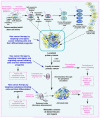New promising drug targets in cancer- and metastasis-initiating cells
- PMID: 20338259
- PMCID: PMC2906246
- DOI: 10.1016/j.drudis.2010.03.009
New promising drug targets in cancer- and metastasis-initiating cells
Abstract
The unique properties of cancer- and metastasis-initiating cells endowed with a high self-renewal and aberrant differentiation potential (including their elevated expression levels of anti-apoptotic factors, multidrug transporters, and DNA repair and detoxifying enzymes) might be associated with their resistance to current clinical cancer therapies and disease recurrence. The eradication of cancer- and metastasis-initiating cells by molecular targeting of distinct deregulated signaling elements that might contribute to their sustained growth, survival, and treatment resistance, therefore, is of immense therapeutic interest. These novel targeted approaches should improve the efficacy of current therapeutic treatments against highly aggressive, metastatic, recurrent, and lethal cancers.
Copyright 2010 Elsevier Ltd. All rights reserved.
Figures


Similar articles
-
Novel therapies against aggressive and recurrent epithelial cancers by molecular targeting tumor- and metastasis-initiating cells and their progenies.Anticancer Agents Med Chem. 2010 Feb;10(2):137-51. doi: 10.2174/187152010790909353. Anticancer Agents Med Chem. 2010. PMID: 20184544 Free PMC article. Review.
-
ATPase inhibitors of heat-shock protein 90, second season.Drug Discov Today. 2010 May;15(9-10):342-53. doi: 10.1016/j.drudis.2010.03.002. Epub 2010 Mar 15. Drug Discov Today. 2010. PMID: 20230904 Review.
-
Novel therapeutics in combination with radiotherapy to improve cancer treatment: rationale, mechanisms of action and clinical perspective.Drug Resist Updat. 2010 Feb-Apr;13(1-2):29-43. doi: 10.1016/j.drup.2010.01.002. Epub 2010 Feb 18. Drug Resist Updat. 2010. PMID: 20167530 Review.
-
Molecular targets in the discovery and development of novel antimetastatic agents: current progress and future prospects.Clin Exp Pharmacol Physiol. 2013 May;40(5):307-19. doi: 10.1111/1440-1681.12083. Clin Exp Pharmacol Physiol. 2013. PMID: 23534409 Review.
-
The long road to colorectal cancer therapy: searching for the right signals.Drug Resist Updat. 2010 Feb-Apr;13(1-2):44-56. doi: 10.1016/j.drup.2009.01.002. Epub 2010 Feb 21. Drug Resist Updat. 2010. PMID: 20176501 Review.
Cited by
-
Aminodi(hetero)arylamines in the thieno[3,2-b]pyridine series: synthesis, effects in human tumor cells growth, cell cycle analysis, apoptosis and evaluation of toxicity using non-tumor cells.Molecules. 2012 Mar 28;17(4):3834-43. doi: 10.3390/molecules17043834. Molecules. 2012. PMID: 22456543 Free PMC article.
-
Aberrant Expression of Cancer Stem Cells Marker Prominin-1 in Low-Grade Tubulolobular Breast Carcinoma: A Correlative Study between qRT-PCR, Flow-Cytometric and Immunohistochemistry Analysis [corrected].J Breast Cancer. 2012 Mar;15(1):15-23. doi: 10.4048/jbc.2012.15.1.15. Epub 2012 Mar 28. J Breast Cancer. 2012. PMID: 22493624 Free PMC article.
-
Overexpression of Cell Cycle Progression Inhibitor Geminin is Associated with Tumor Stem-Like Phenotype of Triple-Negative Breast Cancer.J Breast Cancer. 2012 Jun;15(2):162-71. doi: 10.4048/jbc.2012.15.2.162. Epub 2012 Jun 28. J Breast Cancer. 2012. PMID: 22807933 Free PMC article.
-
Gly322Asp and Asn127Ser single nucleotide polymorphisms (SNPs) of hMSH2 mismatch repair gene and the risk of triple-negative breast cancer in Polish women.Fam Cancer. 2015 Mar;14(1):81-8. doi: 10.1007/s10689-014-9746-z. Fam Cancer. 2015. PMID: 25134804 Free PMC article.
-
Cell and Molecular Processes in Cancer Metastasis: an AJP-Cell Physiology set of Themed Reviews.Am J Physiol Cell Physiol. 2015 Oct 1;309(7):C443. doi: 10.1152/ajpcell.zh0-7813-editorial.2015. Am J Physiol Cell Physiol. 2015. PMID: 26428197 Free PMC article. No abstract available.
References
-
- Schrama D, et al. Antibody targeted drugs as cancer therapeutics. Nat. Rev. Drug Discov. 2006;5:147–159. - PubMed
-
- Gray-Schopfer V, et al. Melanoma biology and new targeted therapy. Nature. 2007;445:851–857. - PubMed
-
- Sorscher SM. Biological therapy update in colorectal cancer. Expert Opin. Biol. Ther. 2007;7:509–519. - PubMed
-
- Sathornsumetee S, et al. Molecularly targeted therapy for malignant glioma. Cancer. 2007;110:13–24. - PubMed
Publication types
MeSH terms
Substances
Grants and funding
LinkOut - more resources
Full Text Sources

